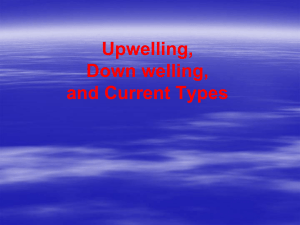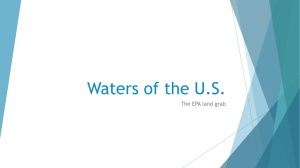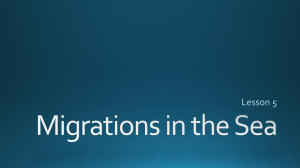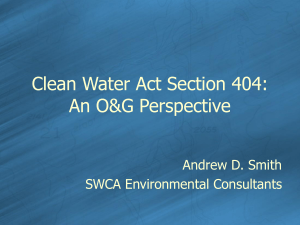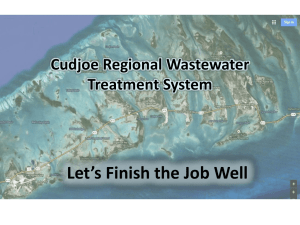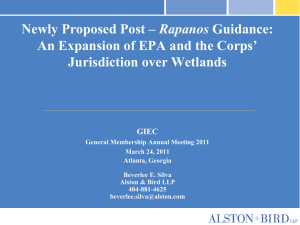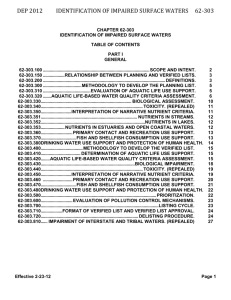Deidre_Duncan49635020_1
advertisement
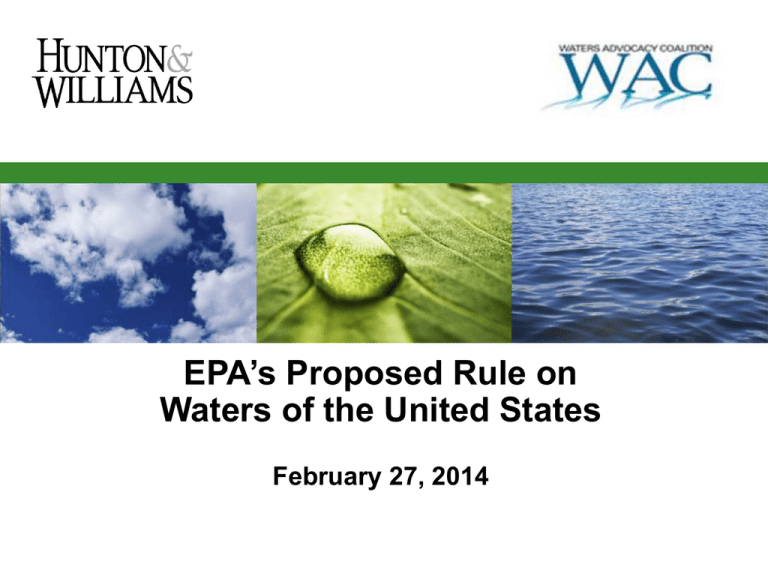
EPA’s Proposed Rule on Waters of the United States February 27, 2014 Background • CWA provides federal jurisdiction over “navigable waters,” defined as “the waters of the United States” • In 1985, in Riverside Bayview Homes, the Supreme Court upheld the regulation of wetlands adjacent to or “inseparably bound up with” navigable waters • The agencies adopted the current regulations in 1986 2 Background • In 2001, the Supreme Court in SWANCC rejected regulation of “isolated waters” under the Migratory Bird Rule because the waters lacked a “significant nexus to navigable waters” − Emphasized Congress’ use of the term “navigable” • After SWANCC, the agencies adopted a broad interpretation that “waters of the U.S.” include any water “connected” to navigable waters 3 Background • In 2006, the Court in Rapanos rejected the agencies’ “any hydrological connection” theory of jurisdiction as overly broad − Plurality opinion (Scalia): • Rejected assertion of jurisdiction over ephemeral streams, ditches, and drains • Relatively permanent waters − Kennedy concurrence: • Joined plurality in rejecting the Government’s any connection theory • Significant nexus 4 2013 “Proposed” Rule • The Proposed Rule replaces the definition of “navigable waters” and “waters of the United States” in the regulations for all CWA programs, and in particular sections 311, 401, 402, and 404: − − − − − − − − − − − − 33 C.F.R. § 328.3 40 C.F.R. § 110.1 40 C.F.R. § 112.2 40 C.F.R. § 116.3 40 C.F.R. § 117.1(i) 40 C.F.R. § 122.2 40 C.F.R. § 230.3(s) and (t) 40 C.F.R. § 232.2 40 C.F.R. § 300.5 40 C.F.R. § 300, Appendix E to Part 300, 1.5 40 C.F.R. § 302.3 40 C.F.R. § 401.11 5 WOTUS Under the “Proposed” Rule 1. 2. 3. 4. 5. 6. 7. All waters currently, in the past, or may be susceptible to use in interstate or foreign commerce, including tidal waters; All interstate waters, including interstate wetlands; The territorial seas; All impoundments of waters otherwise defined as waters of the U.S.; All tributaries of waters identified in 1-3 above; All waters, including wetlands, adjacent to water identified in 1-5 of this section; and On a case-specific basis, other waters, including wetlands, that alone or in combination with other similarly situated waters in the region have a significant nexus to a water identified in paragraphs 1-3 6 New Definitions in “Proposed” Rule • Tributary: − Water body physically characterized by a bed and bank and ordinary high water mark which contributes flow directly or through other water bodies to waters in 1-3. − A water does not lose its tributary status if there are man-made breaks (such as bridges, culverts, pipes, dams) so long as bed and bank can be identified up and downstream of the break. − A wetland can be a tributary. − A tributary can be natural, man-altered, or manmade and includes rivers, streams, lakes, impoundments, canals, and ditches (unless 7 excluded). Tributary Definition • The rule, for the first time ever, specifically defines ditches as jurisdictional tributaries under all CWA programs − Roadside ditches − Irrigation ditches − Stormwater ditches • Other man-made conveyances that drain or connect would also likely qualify as tributaries • Huge practical consequences that have yet to be evaluated 8 Farm Ditch 9 Potomac, Maryland 10 • Roadside ditch constructed and maintained by Wicomico County, Maryland roads department 11 Other New Definitions in “Proposed” Rule • Adjacent: Bordering, contiguous, or neighboring waters separated from other WOTUS by dikes, or barriers are adjacent waters • Neighboring: Waters located within a riparian area or floodplain or waters with a surface or shallow subsurface connection − Riparian area: Transitional areas between water and land where surface or subsurface hydrology influences the ecological process and plant community of the area … − Floodplain: An area bordering inland or coastal areas that … is inundated during periods of moderate to high water flows 12 Industrial Ponds Along the Arkansas River 13 Washington, DC Floodplain 14 Significant Nexus Definition in “Proposed” Rule • Significant Nexus: − Means a more than speculative or insubstantial effect that a water or wetland has either or alone or in combination with other waters in the region on waters 1-3. − Other waters, including wetlands, are similarly situated when they perform similar functions and are located sufficiently close together so that they can be evaluated as a single landscape unit. 15 Exclusions in “Proposed” Rule • Waste treatment systems designed to meet the requirements of the Clean Water Act; • Prior converted cropland; • Ditches excavated in uplands and that drain only uplands and have no more than ephemeral flow; and • Ditches that do not contribute flow either directly or through other water bodies to a water in 1-3 above 16 Exclusions in “Proposed” Rule • Artificially irrigated areas that would revert to uplands should irrigation cease • Artificial lakes or ponds created in dry land and used exclusively for stock watering, irrigation, settling basins, or rice growing • Artificial reflecting pools or swimming pools created by excavating and/or diking dry land • Small ornamental waters created by excavating and/or diking dry land for primarily aesthetic reasons • Water-filled depressions from construction • Groundwater drained through subsurface drainage systems • Gullies, rills, non-wetland swales, and puddles 17 Why Does CWA Jurisdiction Matter? • The amount of jurisdictional waters influences: − Enforcement/likelihood for potential illegal discharges − Permitting/reporting requirements • Type of permit: Nationwide or individual − “Federal action” triggers: NEPA, ESA, NHPA, 401 water quality certification, etc. − Mitigation − Third-party challenge 18 Enforcement 19 Enforcement 20 Spill Prevention and Countermeasure Plan 21 Industrial Facility Implications • Industrial ponds − Refineries − Process waters • Industrial storm water systems − Closing or modifying facilities • Ditches and other conveyances 22 Deidre G. Duncan Hunton & Williams LLP 2200 Pennsylvania Avenue, NW Washington, DC 20037 (202) 955-1919 dduncan@hunton.com

